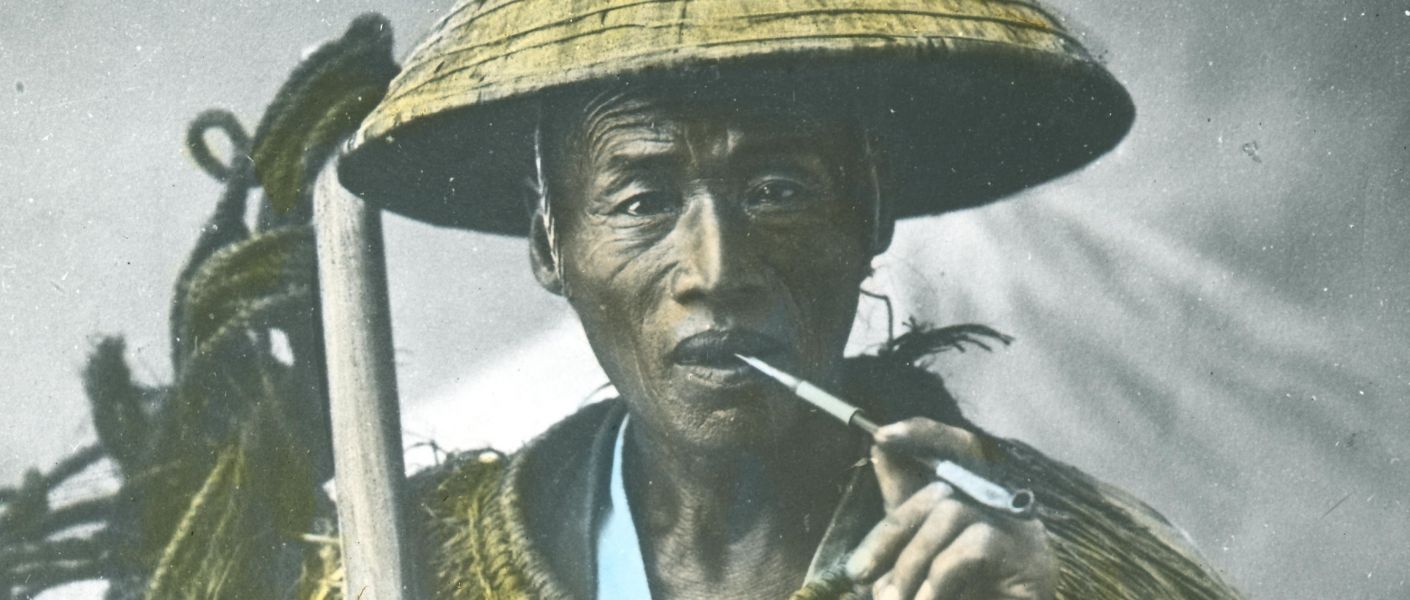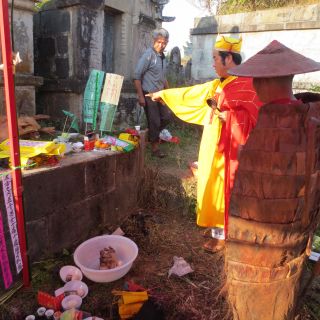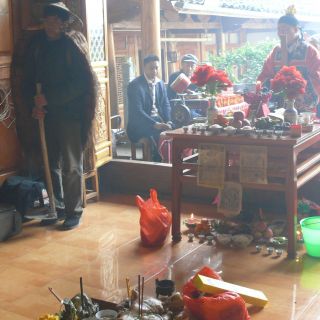The Conciliatory Cape
1. Picture
Utagawa Hiroshige III. (1843-1894): Gate at the Sukiya Bridge (Series title: Tokyo landmarks.)
Japanese Collection, collected by Péter Vay
inv.no. HFM_6972.
‘„Is it snowing?” asked the Ancestress with a glance at Pao Yu’s rough weather-cloak of reddish-brown monkey-hair felt.
“Not yet, but it certainly looks as if it will.”
“Bring him the peacock-feather cloak!” The Ancestress ordered her waiting maid, Mandarin Duck.’
The cloak, or raincoat, which is the focus of this blog post, is made of reddish brown monkey-hair felt in the most famous novel of the classical Chinese literature, namely Dream of the Red Chamber, written by the 18th century Chinese writer Cao Xuejin. It provided protection against rain and snow, as it does today, for farmers in China and Japan, caravans roaming the trade routes, and among the rickshaw-pullers plying in the whirlwind of small towns and rural villages. The storm cloak, which is an integral part of the life of the communities, also appears on the scene of religious rituals that respond to every momentum of everyday life. In most parts of China and Japan, it is made of straw, as can be seen on one of the woodcut series of the Japanese woodcut collection of Count Péter Vay (1863-1948), missionary and Asia explorer, showing the famous places of contemporary Tokyo, and on the photographs purchased by Dezső Bozóky (1871-1957), naval surgeon of the Imperial and Royal Austro-Hungarian Navy, globe trotter and collector, during his trip to Japan in 1908. One of the two surviving studio shots on hand-coloured glass diapositive shows a Japanese farmer in his rain cloak, while the other gives insight into the momentary event of a woman dressed in winter clothes and a rickshaw-puller boy wearing a straw cloak crossing each other’s paths.
However, in many settlements along the Chinese region of the Southwestern Silk Road, the rain cloak is made from palm fibre or, in some places, coir, with bamboo hats added to the garment. The rain cloak (umbrella) is forbidden to be worn during rain-making rituals and is not allowed to be included in the gift list at weddings, yet it is known as one of the symbolic garments of the Yunnan region’s Ancestral cult.
The main ceremonies of the Yunnanese Ancestor cult are performed upon the request of families or temple communities. Five main categories can be defined: Burial, Commemoration of the dead, Ritual of good wishes for peace, Ritual of good wishes for Birthday, and Purification rituals on the Day of the Dead together with the ceremonies of the cult of Earth Mother Goddess organically related to the latter but also known separately.
Two major rites belong to the cult of Earth Mother: the first one is a festival of temple communities on her Birthday. The other group of rituals is called the „Quieting the Dragon and Calming the Earth” or „Thanking the Earth Rite” which has two types depending whether the Mother of Earth as well as the Dragon deity are to be pacified in the Yin or the Yang house. The former is called „Pacification of the Yin house”, the latter „Pacification of the Yang house.” The former is celebrated when the grave of the deceased is renewed or on the Day of the Dead in the cemetery, the latter is held in the family dwelling, to pacify the Dragon deity of the place and give thanks to the deity of the Five directions. These rites are needed because when a grave is renovated or a new house is built or reconstructed, the earth – that is, the Earth Mother Goddess – is wounded, injured. To the ceremony of the „Pacification of the Yang house” a „Gate Opening Rite” may also be attached (depending on the financial means and wish of the client). This is a ritual of letting good luck in.
In the definition of two well-known ritual specialists, Master Liu and Liu Kan, the rite of „Quieting the Dragon and Calming the Earth” is very complex. It begins with the „Opening of the altar” rite and ends with the „Departure of the deities [into their realm]”. This rite takes three days to be performed.
First day: upon a clan’s request, the „Pacification of the Yin house” is performed at the grave of all ancestors of the clan, with offerings to the ancestors and tribute to Goddess Mother of Earth. (If the graves of several family members are side by side, the Soul Plate of the Earth Mother Goddess is placed at the foot of one of the graves. For a free-standing grave she is represented separately.)
Second day: commemoration of the dead, evocation of the period of mourning. Its aim is to perform a thanksgiving ceremony for the salvation of dead parents’ souls in the first or third year after their deaths.
Third day: „Pacification of the Yang house” is carried out in a Buddhist rite, but a Daoist ritual could also replace it. (One photo in the picture gallery gives a glimpse of the Buddhist ritual, the other of the Daoist ritual.)
|
2. Picture Woman dressed in winter clothes and a rickshaw puller boy wearing a straw coat inv. no. HFA_F.2004.419. |
|
3. Picture Japanese farmer’s raincoat inv. no. HFA_F.2004.413. |



